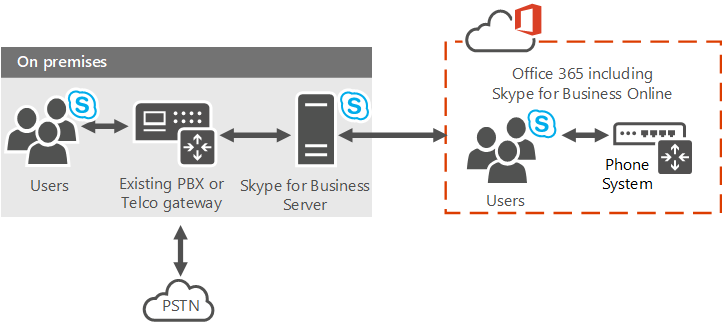Overcoming obstacles to migrating to Cloud based enterprise voice solutions is achievable through clever design options. Some enterprise business infrastructure managers may feel that their legacy voice environment is restricting the migration of voice services to cloud based offerings like Skype for Business or Microsoft teams. However, Microsoft offers a variety of design options for enabling PSTN connectivity for Office 365 accounts or Skype for Business accounts with your on-premise Skype for Business Server deployment. Microsoft Cloud PBX with PSTN access through a Hybrid Skype for Business on-premise deployment can provide a migration strategic vision.
Your goal maybe a full unified communications cloud vision, for example Skype for Business Cloud PABX with Telstra calling for Office 365 plans or a hybrid, but your organization migration strategy may be blocked. This issue may arise for some of the following reasons:
- Locked in TELCO contract or Investments in On-Premises PSTN connectivity
- Legacy PABX infrastructure capital investment.
- Existing On-premise server applications ie: contact centre and call recording Solutions.
- Dependency on analogue infrastructure
With a Hybrid SFB solution It is possible to realise a staged migration to Hosted Cloud PABX services now. Therefore, your migration strategy may be migrating some of the user base now and testing cloud-based telephony until the restricting forces are removed.
In this scenario you can move users to Skype for Business Online Cloud PBX with SFB on-premise PSTN connectivity.
Skype for Business Server Hybrid deployment

The diagram shows a hybrid design that consists of a Skype for Business Server on-premise deployment federated with Office 365. Users can be homed on premises or online in cloud. The users will be able to make and receive calls through existing on-premises voice infrastructure. Notice that existing legacy PABX infrastructure is integrated into the solution. Additional third party gateways from Microsoft qualified gateway provider can deliver multiple connectivity options for legacy infrastructure to integrate into a SFB solution.
Overcoming the barriers for migration to Skype for Business:
- The business can maintain existing TELCO PSTN contracts. Existing PSTN services can terminate on SFB session border controllers that are controlled through the on-premise server. The business can then simply port the existing number range to new Office 365 Telstra PSTN plans when existing contracts expire.
- Integration with legacy PABX solutions can be maintained through SIP or ISDN Links between SFB and 3rd party PABX solutions through a Session Border controller. This can maintain investments in legacy services and also enjoy benefits of Microsoft Cloud PABX and digital workspace.
- Key users on legacy contact centre and call recording applications can remain on existing platforms. Cloud based contact centre solutions can be evaluated and migration strategies separating contact center users from the rest of the business can be created.
- Legacy analogue requirements may be maintained through SFB on-premise servers and provision of analogue gateways
Therefore, if your business objective is progressing to Cloud based enterprise voice infrastructure and committed to Office 365 Cloud PABX as your voice solution then you have migration strategies with a SFB Hybrid design.
Keith Coutlemanis
